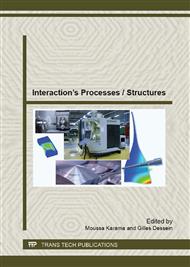[1]
R.A. Toupin, Elastic materials with couple stresses. Arch. Ration. Mech. Anal. (1962),Vol. 11, pp.358-414.
DOI: 10.1007/bf00253945
Google Scholar
[2]
R.D. Mindlin, Second gradient of strain and surface tension in linear elasticity. Int. J. Solids Struct. (1965), Vol. (1), pp.417-438.
DOI: 10.1016/0020-7683(65)90006-5
Google Scholar
[3]
H. Gao, Y. Huang, W.D. Nix, J.W. Hutchinson, Mechanism based strain gradient plasticity-I. Theory. Journal of the Mechanics and Physics of Solids. (1999), Vol. 47, pp.1239-1263.
DOI: 10.1016/s0022-5096(98)00103-3
Google Scholar
[4]
K.C. Hwang, H. Jiang, Y. Huang, H. Gao, N. Hu, A finite deformation theory of strain gradient plasticity. Journal of the Mechanics and Physics of Solids. (2002),Vol. 50, pp.81-99.
DOI: 10.1016/s0022-5096(01)00020-5
Google Scholar
[5]
L. Xinmin, L. Hongtao, L. Chengfeng, L. Zhongqin, N. Jun, Modelling and analysis of micro scale milling considering size effect, micro cutter edge radius and minimum chip thickness. Int. J. Mach. Tools. Mf. (2008), Vol. 48(1), pp.1-14.
DOI: 10.1016/j.ijmachtools.2007.08.011
Google Scholar
[6]
M.F. Ashby, The deformation of plastically non-homogeneous alloys. Phil. Mag., (1970), Vol. 21, p.399–424.
Google Scholar
[7]
U.F. Kocks, H. Mecking, Physics and phenomenology of strain hardening: the FCC case. Prog. Mater. Sci., (2003), Vol. 48, p.171–273.
DOI: 10.1016/s0079-6425(02)00003-8
Google Scholar
[8]
S. S. Joshi, S. N. Melkote, An explanation for the size-effect in machining based on strain gradient plasticity. Journal of Manufacturing Science and Engineering, Transactions of the ASME. (2004), Vol.126(4), p.679–684
DOI: 10.1115/1.1688375
Google Scholar
[9]
U.F. Kocks, The relation between polycrystal deformation and single crystal deformation. Metall. Mater. Trans., (1970), Vol. 1, p.1121–1144.
DOI: 10.1007/bf02900224
Google Scholar
[10]
B. Liu, Y. Huang, M. Li, K.C. Hwang, C.A. Liu, study of the void size effect based on the Taylor dislocation model. Int. J. Plas. (2005), Vol. 21(11), pp.2107-2122.
DOI: 10.1016/j.ijplas.2005.03.016
Google Scholar
[11]
W.D Nix, H. Gao, Indentation size effects in crystalline materials: a law for strain gradient plasticity. J. Mech. Phys. Solids, (1998), Vol. 46, p.411–425.
DOI: 10.1016/s0022-5096(97)00086-0
Google Scholar
[12]
A. Arsenlis, D.M. Parks, Crystallographic aspects of geometrically-necessary and statistically-stored dislocation density. Acta Mater. (1999), Vol. 47, p.1597–1611.
DOI: 10.1016/s1359-6454(99)00020-8
Google Scholar
[13]
Y. Huang, Z. Xue, H. Gao, W.D Nix, Z.C. Xia, A study of micro-indentation hardness tests by mechanism-based strain gradient plasticity. J. Mater. Res., (2000), Vol. 15, p.1786–1796.
DOI: 10.1557/jmr.2000.0258
Google Scholar
[14]
C.J. Kim, Mechanism of the chip formation and cutting dynamic of the micro scale milling process. PhD thesis, (2004), University of Michigan.
Google Scholar
[15]
M. Asad, PhD « Elaboration of concepts and methodologies to study peripheral down-cut milling process from macro-to-micro scales » Université de Lyon, INSA, (2010), 128 P.
Google Scholar
[16]
M. Asad, T. Mabrouki, F. Girardin, Y. Zhang, J.-F. Rigal, Towards a physical comprehension of material strengthening factors during macro to micro-scale milling. ISSN 1392-1207. MECHANIKA. (2011), Vol. 17(1), pp.97-104.
DOI: 10.5755/j01.mech.17.1.210
Google Scholar


